Elka/Unicord
Elka made quite a number of different combo organs, most of the ones I've run across were marketed under the Unicord name. The Unicords say "Manufactured by Elka" on the name plate(Supposedly, Unicord eventually became Korg). Most were called Panther, or some variation. Some were also marketed under the "Capri" names. It's been suggested that the "Panther" line was intended for the US market, and that the "Capri" line was intended for the Latin countries (Spain, Italy, etc.). The word "Capri" is the same in both English, Spanish an Italian, but "Panther" translates to "Pantera" in Spanish.
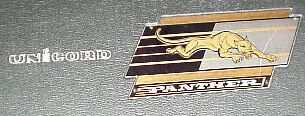
|
| Cool looking organs. Cool name. Cool logo. |
The 300's little brother. I now own one of these, so I can comment a bit more about it:
This is the one of the few combo organs I know of that has a built-in amp and speakers. The power cord connector takes a standard 2-prong extension cord - no need for a special one. As designed, there's no way to shut off the internal speaker, but I may try to modify mine so it does just that when a cord is plugged into the output jack. With the Bass Bourdon tab off, the lower octave plays the treble voices, and with it on, the it plays a only a bass sound. Some of these had black/white keys for the lower octave, and others had Grey/Black keys. I don't think there's any functional difference. The voices are decent sounding, about what you'd expect, nothing strange or unusual. The vibrato is kind of odd, in that when you turn it on, it first drops the pitch a bit, then starts going - takes about a half-second altogether. It's a fairly nice effect, with a *somewhat* Leslie-like quality, but if used for the Vibrato on/off passages in songs such as "Steppin' Stone" or "In-A-Gadda-Da-Vida" it would a bit strange. I understand that the other Panthers (at least the round-top models) have the same type of Vibrato. Also, when adjusting the speed knob, it takes it a moment to change speed - again, sort of Leslie-like.
Controls:
· Knobs: On/Off/Volume, Vibrato Speed, Vibrato Depth.
· Bass Voice Tabs: 16' Bourdon
· Treble Voice Tabs: 16' Flute, 16' Strings, 8' Flute, 8' Diapason, 8' Strings, 8' Trumpet
· Effect Tabs: Vibrato Off/On.
One vendor for the Panther 100 was Lafayette Electronics. The following pic is from a 1970 Lafayette catalog. It sold for $299. It also appeared in the 1969, 1971 and 1972 Lafayette catalogs, but not in 1973.
I think this one's most unusual feature is the short keyboard - 37 keys on top, and only 30(!) on the bottom. Most organs have nearly that many on only one keyboard. It looks like a sawed-off version of the Panther 2200 (below) - the controls and everything are almost identical. Oddly enough (at least, according to one owner), the 200 comes with the same curved chrome legs as the Panther Combo 300 albeit, with no nameplate on the crossbar, rather than the inverted "T" stand like the 2200 (the "X" stand shown is, of course, not stock)
Controls:
Upper Manual:
Lower Manual:
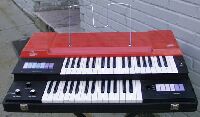
 Photos courtesy of Boss Guitars
Photos courtesy of Boss Guitars
This is probably the most common one, and is pictured in Mark Vail's book. It was available in several color combinations, four of which are pictured here. I've also heard from one owner of a Grey one. There may have been more.
Controls:
· Knobs: Off/On, Bass Volume, 16', 8', 4', M
· Effect Tabs: Bass Extension, Vibrato Off/On, Light/Heavy, Slow/Fast, Tone Decay(Mixture)
· Bass Voice Tabs: Bass Bourdon 16', Bass Dulciana 16'
· Treble Voice Tabs: Bourdon 16', Contra Oboe 16', Strings 16', Open Diapason 16', Flute 8', Strings 8', Clarinet 8', Oboe 8', Flute 4', Strings 4', Salicet 4', Mixture I, Mixture II
The output is "stereo", requiring a TRS plug split to two mono 1/4" plugs to separate the treble and bass outputs.
The level of the 16', 8', 4' and Mixture voices can be infinitely varied via the knobs - very nice idea. The Mixture tabs are a combination of 2-2/3', 2' and 1-3/5' voices, Mixture I is described as "Harsh", and Mixture II as "Mellow". The Tone Decay tab adds an attack Percussion effect to the Mixture tabs only. The Bass Extension tab extends the bass section into the Gray keys, providing 24 bass keys.
Here's a comment from a happy Panther owner: "... it is somewhat similar to the Farfisa Compact series in variety of voices, but none of the Panther's voices seem to get quite the same bite as the Farfisa's ALL BOOSTER. A few of the voices could easily be mistaken for a Continental."
The Combo was available at least as early as 1966, according to a sales brochure I have. Since the Panther 100 was available at least as late as 1972, and they look so similar, the Combo may also have been produced until that date, for a total lifetime of at least 6 years.
Panther Duo Deluxe/Capri Duo (400)
Looks like a dual-keyboard version of the Panther Combo, but with a few more features. Except for the tab colors, the Panther and the Capri appear to be identical. While it's similar, this is not the elusive dual-keyboard version of the squaretop Panther Duo listed above.
Controls:
Upper Knobs: I'm not certain, but probably: Off/On, 16', 8', 4', M
Upper Tabs:
Lower Dials: Repeat Rate, Pedal, Lower, Upper
Lower Tabs:
On the left is the Panther Duo Deluxe, on the right is the Capri Duo.
The first in the line of "squaretop" Panthers. This one looks identical to the Capri Jr, so I assume they're the same organ.
Controls:
|
Panther 2100 |
Capri Jr. |
Capri Jr. |
Pat's
2150 (shown below) is cosmetically somewhat different from the one above
(no woodgrain, different colors). It looks a lot sharper, don't you think?
Nice organ, Pat - I bet you're proud! (He bought this fellow new in 1970!)
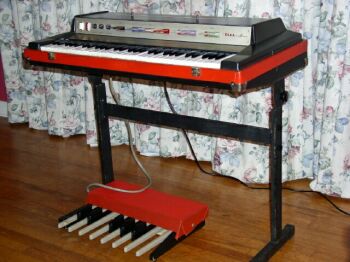
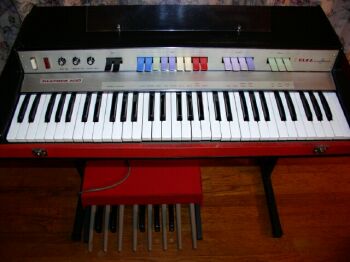
Controls

The 2200 seems to be the big brother to the 200 - note the many similarities. Even though it's larger, it's actually lighter than the 200. Also, the panels where the tabs & knobs are mounted are plastic, rather than the metal found on the 200. It does have the "inverted T" stand found on the 2000 series, rather than the tubular chrome stand of the 200 and 300.
Controls:
Upper Manual:
Lower Manual:
|
|
|
|
From an Elka promo sheet. Click on the picture to see the whole sheet. |
The 2200 in action with "The Partridge Family" |
I don't have a picture of this one, but I have the following description, from a 1970 service manual. Thanks to Kirk for this:
Keyboards: 2 44-note manuals
Controls:
Upper Manual
Voices: 16' bourdon, 8' Flute, 8' Strings, 8' Trumpet,
8' Oboe, 4' Flute, 4' Strings, Mixture
Effects: Tone Decay, Repeat, Piano, Spinet, Harpsichord, Short/Long
Vibrato: On, Heavy, Fast
Lower Manual:
Voices: 16' Bourdon, 16' Dulciana, 8' Flute
Effects: Soft, Sharp, Bass, Short/Long
Controls: (I can't really sort them all out in order - just click on the picture and you'll see the descriptions)
This one probably won't turn up on stage with any surf band, but it's kind of fun to imagine what combo organs would have evolved into if synthesizers hadn't taken over
Not really a true Combo Organ (by my definition, anyway), but rather a "Hammond emulator". 1 keyboard, 9 drawbars, 6 presets, percussion 5 1/3’ 4’ 2 2/3’ & 2’, percussion volume & decay, Leslie simulator, keyclick & overdrive sliders, built-in light-duty road case.
There's a review of here it at SonicState
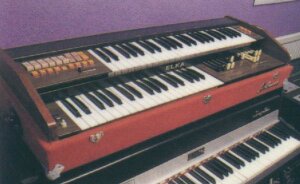 |
I'm not 100% certain that this is an
X-55, and the owner could not find any id info on it, but my original
description, "2 keyboards, 9 drawbars on upper,
5 drawbars on lower keyboard" is pretty close. The red covering is non-original
(see below) This photo is from an article in "Sound on Sound" magazine. |
Thanks to Simon R. for these pictures. Here is his initial description explains the reason for the re-upholstering:
"It is dual manual drawbars, 9 for top manual 6 for bottom it has percussion, key click button, sustain on both manual (seperate) a brilliance rocker button. some piano sounds (very awful) including clav and bells (i never use these) It was covered in black Tolex, this was ripped so I re covered it in red suede (kinda cool) Unfortunately the stand was missing and I wish to get one at some point. The stand connects to screw points at either end (same as the Elka Synthex)."
Controls:
And here's a slightly different version - differing only (as far as I can tell) by the buttons under the tabs on the top manual:
Rather than the Presets and the Piano effect, it has Clarinet, Trumpet, Full Organ, Theater and Drawbars.
(Thanks to Jan B. for these last three pictures)
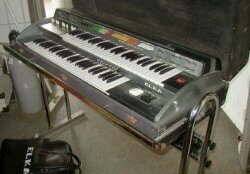 |
My original
description for this one was: "2 4-octave keyboards,
14 drawbars, 21 tabs" |
"Full set of Hammond-clone drawbars with seven percussion settings, a full drum machine that was quite impressive for the time, and an 11-preset synth with sounds like guitar, trombone, clarinet, and sax. The synth sounds were polyphonic on the top manual and monophonic on the bottom and pedals. Used by Jean-Michael Jarre. Made from '77 to '81, original price £2662." (Thanks, Les!)
Following is a review from another happy X-705 owner:
"It has full drawbars for top and bottom. It also has a string/cello synth (polyphonic), like the Elka Rhapsody, available on both manuals, as well as a "piano", and "harpsi". There are a few organ presets and synth presets (polyphonic) for the top manual, and a position where you can create your own organ sound. There is also a very cool, cheesey mono synth voice on top, with controls for filter cutoff, resonance, portamento, vibrato, attack, and release. There are a dozen presets for this, which can be modified if you press the "var" button. They range from surprisingly good imitative sounds (trumpet, etc.) to spacey things. Very Superfly. All of these elements (except organ + polysynth) can be layered for some really queasy textures! Not only is there an analog rhythm machine (presets), but also[a] fairly sophisticated auto accompaniment which follows the chords you play on the lower manual. This auto accompaniment section has it's own set of analog synth generators for "piano", "brass", "guitar", and "bass", and several modes of use. There is a spring reverb, and also release sliders for many of the sounds, including the organ, which gives a spacey sound like a plaster echo chamber. You can play bass in one octave of the lower manual, or switch to the pedalboard. There are controls for an Elkatone leslie, but the connector is incompatible with my Elkatone, sadly. So, this thing contains a poly synth, a mono synth with controls, 2 organs, 2 string machines, two clavs, two pianos, 1 manual/pedal bass, separate generators for accompaniment bass/guitar/piano/brass, and a full kit of analog drums! The inside is beautiful, with the many circuit cards neatly held into place with a clever system of braces - looks very durable. Only weak point is tab switches...
|
|
|
|
I found this album for sale on Ebay. The organ on the cover is an X-705. |
And here’s an actual X-705. Thanks for the picture, Danny! |
And now, ladies and gentlemen, this is possibly the weirdest organ I think I've ever seen (even more so than the tuck'n'roll Kustom Kombo). Yes, I believe it really is an organ.
Thanks to Ray also for the following detail on the controls on this unusual creature.
TOP ROW - 25 ON/OFF BUTTONS WITH INTEGRAL LAMPS (SOME FLASHING ON FIRST NOTE OF BEAT):
LEFT SIDE VERTICALSLIDERS (All marked on a scale of 0-8)
TABS: 25 in two sets
RIGHT SIDE VERTICAL SLIDERS (All marked on a scale of 0-8):
RIGHT SIDE BUTTONS (ASSOCIATED WITH RIGHT HAND SLIDERS 2-7):
3 GROUPS OF BUTTONS BETWEEN LEFT-SIDE SLIDERS AND DRAWBARS:
DRAWBARS (All marked on a scale of 0-8):
MIDDLE ROW PRESET BUTTONS WITH LAMPS (SOLO):
LOWER ROW PRESET BUTTONS WITH LAMPS (TREBLE):